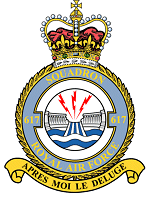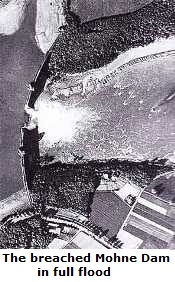
 In
1937 a list of thirteen plans was drawn up known as the Western
Air (WA) Plan, WA 5 was designed to “attack the German War
industry including the supply of oil with priority to that in
the Rhur, Rhineland and Saar”. It was argued, with
misplaced optimism, that this would require about 3,500 sorties
with the loss of 175 aircraft. (Bomber Command was to
loose 8,500 aircraft and 55,000 officers and NCOs.) The Air
Targets sub-committee proposed as an alternative the destruction
of the Mohne and Sorpe Dams. The Ministry of Economic
Warfare concurred, emphasising that both the Mohne
and Sorpe dams must
be breached at the same time. In
1937 a list of thirteen plans was drawn up known as the Western
Air (WA) Plan, WA 5 was designed to “attack the German War
industry including the supply of oil with priority to that in
the Rhur, Rhineland and Saar”. It was argued, with
misplaced optimism, that this would require about 3,500 sorties
with the loss of 175 aircraft. (Bomber Command was to
loose 8,500 aircraft and 55,000 officers and NCOs.) The Air
Targets sub-committee proposed as an alternative the destruction
of the Mohne and Sorpe Dams. The Ministry of Economic
Warfare concurred, emphasising that both the Mohne
and Sorpe dams must
be breached at the same time.Operation Chastise was launched on the night of the 16 - 17th May 1943 by a force of 19 Lancasters split into three formations. The first formation led by Gibson himself was to attack the Mohne Dam and then if they had any bombs left to go on to attack the Eder Dam. There were three waves of three aircraft taking off with ten minutes between each wave. The first wave consisted of Gibson, Hopgood and Martin. The second wave comprised of Young Astell and Maltby and the third wave Maudslay, Knight and Shannon. Formation two comprised of a single wave of five aircraft in loose formation. The captains were: McCarthy, Byers, Barlow, Rice and Munro. This wave was to attack the Sorpe Dam. McCarthy found his own aircraft unserviceable was obliged to transfer to the reserve aircraft. |
|
|
.